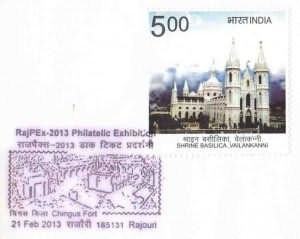One of the most prominent routes undertaken by the Mughal incepted from Gujrat (in Pakistan) to Srinagar. It was divided into 14 halting stations/ sarais and out of which Chingus Fort/Sarai is considered one of the oldest. The Sarai is located in a small village named Chingus that boasts of a rich landscape due to the presence of the Tawi River. However, the Sarai is located on the right bank of the Sukhtao river between Nowshera and Rajouri. It was constructed by Iranian engineer Ali Mardan Khan during Jahangir’s reign as a one-night refuge in Rajouri during their travels. According to G.T. Vigne, Jahangir would undertake his Kashmir travels via Rajouri due to the extensive facilities the Rajas of Rajouri provided.

The Rajas had initially named the place Khanpur however, it became prominent for its cultural and associational value with the Mughals as they frequently undertook the Road. It was only after establishing Jahangir’s tomb that the place became known as Chingus, meaning intestines in Farsi. The story has it that Jahangir’s death on his way to Delhi in 1627 AD put forth a complex circumstance in front of the Empress, Noor Jahan. Being strategic and pragmatic, she decided to keep his death a secret from the people back in the capital and also the ones accompanying them in the caravan. It was a huge risk undertaken to refrain from any war of succession. They decided to prop up the body on the royal elephant to give the impression of Jahangir being alive. However, there was a slight issue concerning the smell emanating from the dead body. As a reason, the intestines and the entrail were removed. Some versions interestingly mention the subsequent killing and burial of the doctor to maintain absolute secrecy. Therefore, one finds another grave of Jahangir lying in Shahdara Lahore, Pakistan.
While the tomb is a later creation, the Sarai comes with 44 small hujras/ residential cells and 3 Dalaans. The outer walls are covered with lime plaster and divided into shallow rectangular panels and arches. The Sarai is enclosed with high fortified walls with bastions at the corners that one can access through the staircases from the terraced roofs beside the cells. The residential cells are built with enclosures and arched cells while facing the courtyard through a separate gate internally connected. Large pebbles and lakhauri bricks in lime surkhi mortar are extensively used in their construction. The central chamber is also decorated with an arched roof with a guard’s room and shops on either side. While these are incorporated with niches, the imperial chambers have rectangular sunken panels. The pleasure garden at the south comes with a three-way access – imperial chamber, second enclosure and outside. The mosque is centrally located in the courtyard with a triple iwan ( vaulted space) and is enclosed on three sides while the fourth is open to the court.

The narrative associated with the Chingus Fort doesn’t end with this as after Partition it functioned as a police station. The Chingus Sarai would be a state-protected monument under the J&K Ancient Monuments Preservation Act 1977. However, with rising insurgency and the army establishing its outpost, the Sarai would be ceased from public viewing. Thus, it was only after 1998 that conservation work was introduced; however, constant negligence in its functioning led to further issues with its maintenance. While the fort would and is still frequently seen with unchecked vegetation, the inclusion of cement in the lime surkhi compromised the authentic conservation of the site. Moreover, the absence of maintenance led to the collapse of a cell on the fort’s northern side.
Post-2003 conservation work by the Department of Archives, Archaeology, and Museums revolved around the removal of material earlier used. Instead, lime surkhi mortar was applied to retain its authenticity. The cells were conserved except one in the northeastern corner that was left unrestored to allow visitors to imagine the monument with its past and present.
The lime surkhi pit has also been left intact within the Sarai courtyard as a witness to the authenticity of materials used for conservation works. Under this, structural facilities such as benches and gazebos were constructed. However, there is still a need to improve its infrastructure facilities like toilets and drinking facilities to function as a historical and tourist complex. The mosque also underwent conservation with the erection of the Qibla wall in the courtyard, its electrification and whitewash and the painting of the mosque for the localities.
While many school children and history enthusiasts undertake their educational trips to the Sarai, several aspects should be brought to light ranging from bureaucratic mishandling to miscommunication or absent communication with the Department of Archives, Archaeology, and Museums. The isolated study of regions beyond the national territories is another issue that needs immediate emphasis so that scholars, locals and beyond can contribute to the popularisation of the Mughal Road history.

